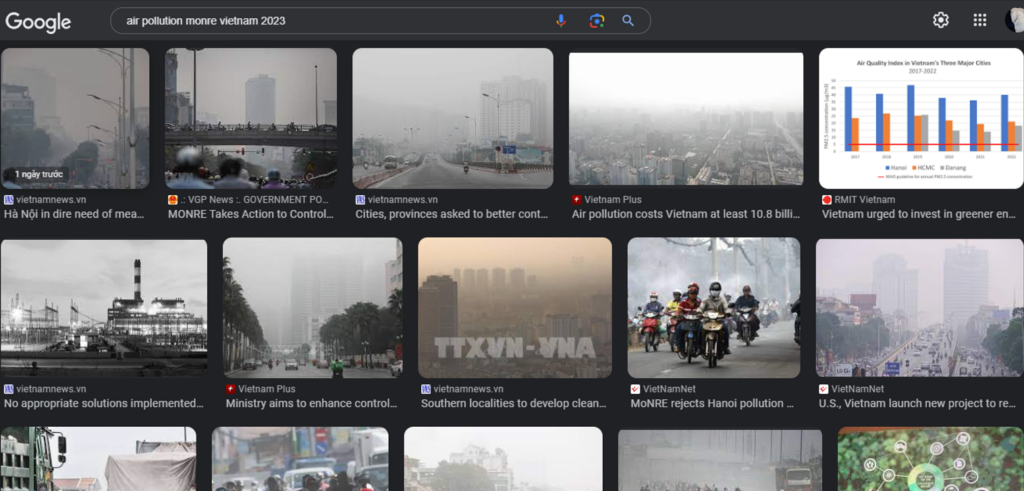Photo: A window screenshot of a Google searche of “air pollution monre vietnam 2023” at 10AM 19 December 2023
“Air pollution” is defined by some organizations [1, 2, 3, 4] in some ways, but generally is when harmful substances are present in the air. The harmful substances (pollutants) consist of particles, gases, or matter released from natural or human activities into the air and reduce the air quality.
Air pollution may be caused by natural activities such as sandstorms, wildfires, volcanic eruptions, etc. These events are the primary sources of air pollution in some areas due to the huge volume of waste and long-distance transport. Sandstorm, frequently occurring in many arid and semi-arid regions of the world, contains environmental pollutants that could increase the concentration of carbon monoxide (CO) by 84.25%, particulate matter of 2.5 microns or less in diameter (PM2.5) by 76.71%, ozone (O3) by 40.41%, NO2 by 12.03% and SARS-CoV-2 cases by 33.87% [5]. In the meantime, wildfires have been investigated to increase the ambient concentration of most air pollutants (PM2.5, CO, NO2, and O3) in Brazil over a long time of over 16 years [6]. A volcanic eruption could release harmful particles and gases, including carbon dioxide (CO2), sulfur dioxide (SO2), hydrogen chloride (HCl), hydrogen sulfide (H2S), Radon (Rn), hydrogen fluoride (HF), sulfuric acid (H2SO4) [7].
Man-made sources of air pollution are transportation, industry, household activities, etc. These sources are considered predominant and increasing due to the world population growth time after time. The transportation activities in the United States of America account for the emissions of approximately 45% of NOx, less than 10% of VOCs, and less than 10% of PM2.5 and PM10 [8]. In Australia, based on the 2019 National Pollutant Inventory (NPI), among the emissions for 93 selected pollutants that are emitted to the environment, predominantly from industrial sources, including CO, Pb and its compounds, SO2, NOx, PM2.5, PM10, benzene, toluene, xylene, formaldehyde and polycyclic aromatic hydrocarbons (PAHs) [9]. Household activities like cooking and open trash burning may release CO, PM2.5, and PM10 contaminants into the air environment in or around the home. According to the World Health Organization (WHO), about 3.2 million people die prematurely from illnesses attributable to household air pollution caused by the incomplete combustion of solid fuels and kerosene used for cooking annually [10].
To combat air pollution, several laws and policies have been issued by the local states and international entities, together with issuing guidelines on air quality by some organizations. However, the participation of each individual is also a key factor to help us succeed in this fight.
By: Nguyen Duy Hung, SOLEN Director – IPC program Director
Edited by: Hendra WINASTU, SOLEN Principal Associate – IPC panel coordinator
Date: 19 December 2023
Article#: SOLEN-IPC-0030
Ref:
[1] Cambridge Dictionary. (2023, December 13). air pollution. @CambridgeWords. https://dictionary.cambridge.org/dictionary/english/air-pollution. [2] World Health Organization: WHO. (2019, July 30). Air pollution. Who.int; World Health Organization: WHO. https://www.who.int/health-topics/air-pollution#tab=tab_1.United Nations [3] Air pollution | UNICEF Parenting. (n.d.). Www.unicef.org. Retrieved from https://www.unicef.org/parenting/air-pollution?gclid=CjwKCAiA-P-rBhBEEiwAQEXhH85NrIK4c0jG596KP7nzomrKP43j0prjgFm2W6DbtHm9CUKKXSMDhhoCPVQQAvD_BwE [4] National Geographic. (2022, July 1). Air Pollution. Education.nationalgeographic.org; National Geographic. https://education.nationalgeographic.org/resource/air-pollution/ [5] Meo, S. A., Almutairi, F. J., Abukhalaf, A. A., Alessa, O. M., Al-Khlaiwi, T., & Meo, A. S. (2021). Sandstorm and its effect on particulate matter PM 2.5, carbon monoxide, nitrogen dioxide, ozone pollutants and SARS-CoV-2 cases and deaths. Science of the Total Environment, 795, 148764. https://doi.org/10.1016/j.scitotenv.2021.148764 [6] Igor Cobelo, Francisco Jablinski Castelhano, Borge, R., Roig, H. L., Adams, M., Amini, H., Petros Koutrakis, & Requia, W. J. (2023). The impact of wildfires on air pollution and health across land use categories in Brazil over a 16-year period. Environmental Research, 224, 115522–115522. https://doi.org/10.1016/j.envres.2023.115522 [7] Volcanic Air Pollution and Health | Air | CDC. (2023, April 6). Www.cdc.gov. https://www.cdc.gov/air/volcanoes-air-pollution.htm#:~:text=Volcanos%20and%20Air%20Pollution [8] US EPA. (2015, September 10). Smog, Soot, and Other Air Pollution from Transportation. Www.epa.gov. https://www.epa.gov/transportation-air-pollution-and-climate-change/smog-soot-and-other-air-pollution-transportation [9] Major air pollutants from industry. (2019, February 22). Department of Environment and Science. https://www.stateoftheenvironment.des.qld.gov.au/pollution/air-quality/major-air-pollutants-from-industry [10] WHO. (2023). Household air pollution and health. Www.who.int. https://www.who.int/news-room/fact-sheets/detail/household-air-pollution-and-health#:~:text=Household%20air%20pollution%20was%20responsible


 Tiếng Việt
Tiếng Việt 日本語
日本語